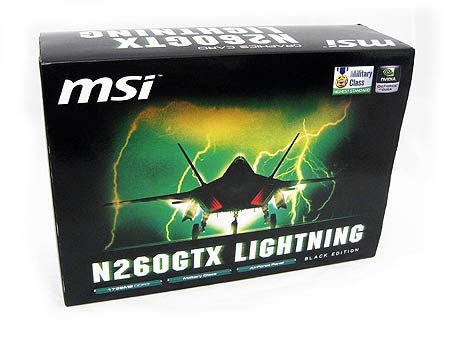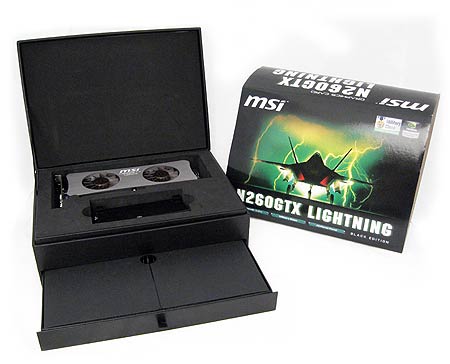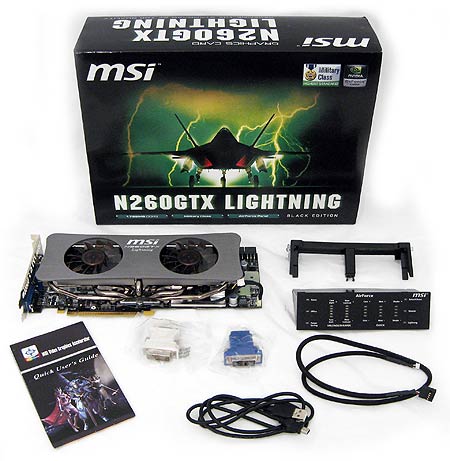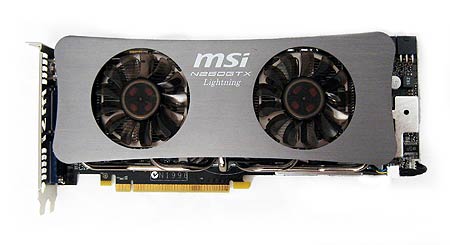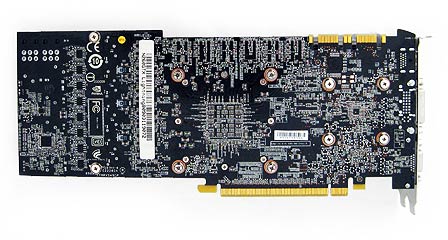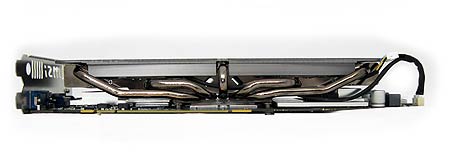GeForce 9600 GT/GTS 250/GTX 260 Non-Reference Roundup
MSI N260GTX Lightning Black Edition
Lastly, we'll look at a very different rendition of the GeForce GTX 260: MSI's N260GTX Lightning.
MSI is taking a clear shot across the bow of the Asus ENGTX260 Matrix with this card. Just consider the specifications: 1,792 MB of video RAM (which is the most on a single-GPU GeForce GTX 260, as far as we’re aware) and 10-phase power. For the Black Edition, MSI also offers a touch-sensitive overclocking control panel called the AirForce Panel, which can be installed in your case or used as a remote from your desk.
Since our test sample included the Black Edition extras, we got to play with the AirForce Panel. We also got the Premium Black Edition packaging that includes a slick storage case. It won't make any difference to our performance story, of course, but we admit it certainly left a positive impression.
Our pre-release sample didn’t include the final bundle, so it’s difficult to know exactly what will be in the retail boxes. Our sample, however, had a driver CD, a DVI-to-HDMI adapter, a DVI-to-VGA adapter, the AirForce panel, and both internal and external USB cables for the AirForce panel.
As for the card itself, MSI has made significant modifications to the PCB compared to the reference design. As mentioned, MSI employs a 10-phase VRM. The card also sports twice the memory of other GeForce GTX 260 cards, with a full 1,792 MB of memory. It’s built with premium capacitors (according to MSI) and the PCB has voltage check points conveniently located for overclockers.
The cooler is a twin-fan, dual-slot unit called the Twin Frozr, which uses five heatpipes to dissipate heat quickly. It doesn’t have a passive mode, so the fans are always active during operation.
Get Tom's Hardware's best news and in-depth reviews, straight to your inbox.
Current page: MSI N260GTX Lightning Black Edition
Prev Page Asus ENGTX260 Matrix, Cont’d Next Page MSI N260GTX Lightning Black Edition, Cont’d.Don Woligroski was a former senior hardware editor for Tom's Hardware. He has covered a wide range of PC hardware topics, including CPUs, GPUs, system building, and emerging technologies.
-
Mottamort I was rather disappointed with this article. Not the article itself but with the slightly misleading Title/Intro. When clicking the article I thought I was going to find a massive battle between these vendors on different tiers, instead you show us different instances of 2 slightly different cards of the same type from one vendor....if that makes senseReply
I mean you have Gigabyte vs Gigabyte in the 9600gt section, Asus vs Asus in the 250 section and so on.
:-/ -
dragonsprayer Great articleReply
i wish it had more cards, i think you need 4 parts, try some back cards like the 4870x2 darkknight? good stuff as always!
thx! -
crisisavatar wow how is the gts 250 performing so close to the gtx 260 wasn't the gtx 260 20% faster ?Reply -
enterco It's not clear to me why are you comparing '3dmark score' when you should post 'GPU score'.... It's a graphics card comparision, not platform comparision.Reply -
randomizer entercoIt's not clear to me why are you comparing '3dmark score' when you should post 'GPU score'.... It's a graphics card comparision, not platform comparision.Nothing but the cards is changed so you're not comparing platforms.Reply -
acasel We cannot see clearly the bang for the buck card there if we ain't seeing some ati cards like the 4770 and others..Reply
The drop down menu sure is fast... :-) -
enterco randomizerNothing but the cards is changed so you're not comparing platforms.Sure. A reason more to show GPU score. 3dmark score is too much influenced by CPU's power, and it's no longer relevant, the way it used to be once...Reply
By using a Quad Core and a low-performing GPU you can achive same 3dmark score as using a dual core combined with a considerably stronger GPU, 3dmark Vantage gives too much credit to CPU. But the overall FPS in games it's often higher in the second case: dual core + better GPU. -
marraco Recent review showed the 260 being neck to neck with the 4870; both in price and performance, those cards are in the same point.Reply
Since my 8800GT should be between the 9600 and the 250, I guess that the best upgrade path is to buy a second 8800GT, reaching probably 260/4870 performance.
I searched the web for 8800GT SLI benckmark running in i7 920, but got no one single review...
I think that tomshardware should review non up-to-date cards as the 8800 and the ATI equivalents, in crossfilre/SLI, since for many users, it should make sense to buy a second card that to upgrade to a 260/4870.
older reviews on those cards does not accounted for the scalability on I7 x58 platform, and probably ATI and Nvidia dedicated more time tweaking drivers for newer cards, so maybe the 8800GT does not perform well today (the SLI on core 2/Quad did not worked very well in the past)
